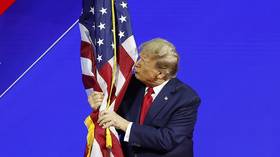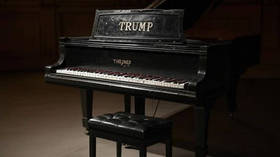‘Demonic destiny’: Long history of US threats to N. Korea

The US is considering “all options” against North Korea, the Trump administration has said, escalating tensions with Pyongyang over the country’s nuclear weapons program and missile tests, and reviving one of the world’s longest unresolved conflicts.
On Monday, US Vice President Mike Pence made an unannounced visit to the demilitarized zone (DMZ) along the border between South and North Korea, and declared the “end of strategic patience” toward the North. President Donald Trump was blunter, saying that North Korea “gotta behave.” The saber-rattling comes after the latest North Korean missile test, which failed Sunday.
READ MORE: ‘Era of strategic patience’ by US towards N. Korea is over – Pence
Korea was ruled by Japan from 1910, then occupied by US and Soviet troops in 1945. The Republic of Korea was established in May 1948 in the US-occupied southern portion of the peninsula. The Democratic People’s Republic of Korea was set up in the north four months later, under the Communist leader Kim Il-Sung. DPRK forces invaded the South in June 1950, seeking to reunify the country by force. When US-led UN troops intervened and advanced into North Korea, China got involved as well. The resulting stalemate was frozen by a 1953 armistice.
Obama: ‘We could destroy you’
Trump and Pence’s statements are a shift from the policy embraced by Barack Obama, whose policy in the Korean peninsula was to deploy the THAAD missile defense system in the South as a counter to “relatively low level threats” from North Korean rockets.
“We could, obviously, destroy North Korea with our arsenals,” Obama told CBS News in April 2016. “But aside from the humanitarian costs of that, they are right next door to our vital ally, Republic of Korea.”
Obama on why the U.S. won't "destroy North Korea": https://t.co/st3jmFibdEpic.twitter.com/MC7hwvVPfd
— CBS Evening News (@CBSEveningNews) April 26, 2016
Bush: ‘Axis of evil’
North Korea was described as part of the “axis of evil, arming to threaten the peace of the world,” by George W. Bush, during his State of the Union speech in January 2002.
On This Day, 2002: In his State of the Union, George W. Bush unveiled his “Axis of Evil” - saying North Korea, Iran and Iraq were members pic.twitter.com/WMEhWq6Awf
— West Wing Reports (@WestWingReport) January 29, 2017
North Korea responded by resuming its nuclear weapons program, which was on hold after a 1994 deal with the Clinton administration, expelling International Atomic Energy Agency (IAEA) inspectors from the country, and withdrawing from the nuclear non-proliferation treaty (NPT) in January 2003.
Reagan: ‘Uncivilized’
Ronald Reagan condemned North Korea’s “uncivilized behavior” during a November 1983 speech to the Korean National Assembly in Seoul.
“North Korea is one of the most repressive societies on Earth. It does not prosper, it arms,” Reagan added.
Nixon and Johnson: Almost nuclear
In April 1969, Richard Nixon asked for military options – including a possible nuclear strike – after North Korea shot down a US EC-121 spy plane over the Sea of Japan. By 1971, however, he reduced the number of US troops in South Korea by almost 20,000, as part of his policy of détente with China.
Lyndon Johnson also considered a nuclear strike in January 1968, following the North Korean capture of the US spy ship, USS Pueblo. The ship’s crew was eventually returned after almost a year in captivity, though the vessel itself remained in North Korea as a trophy.
Truman: ‘Direct challenge’
On June 27, 1950, Harry S. Truman “ordered United States air and sea forces to give the Korean Government troops cover and support,” along with bolstering US forces in the Philippines, giving a security guarantee to the Chinese government in exile on Taiwan (Formosa) and sending aid to France in Indochina, thus first involving the US in what would become the Vietnam War.
Great picture of Truman ordering his troops into action against North Korea 64 years ago today. Showdown with Russia pic.twitter.com/rlAqji5Sac
— Paulius Kuncinas (@kuncinas) June 25, 2014
“By their actions in Korea, Communist leaders have demonstrated their contempt for the basic moral principles on which the United Nations is founded. This is a direct challenge to the efforts of the free nations to build the kind of world in which men can live in freedom and peace,” Truman declared in the address to the nation on July 19.
While the US troops under Gen. Douglas MacArthur did turn the tide of war, their advance into North Korea prompted a Chinese intervention, dangerously escalating the conflict. When MacArthur urged a nuclear attack on China and sealing the Korean border with “a belt of radioactive cobalt,” Truman fired him in April 1951.
Eisenhower: ‘No demonic destiny’
During his 1952 campaign for president, Dwight Eisenhower vowed he would go to Korea and end the war.
“No demonic destiny decreed that America had to be bled this way in order to keep South Korea free and to keep freedom itself self-respecting,” he declared in October 1952.
“We are not mute prisoners of history,” he added. “That is a doctrine for totalitarians. It is not a creed for free men.”
Eisenhower goes to Korea - Nov 29, 1952 - https://t.co/Pa27bG8Mfqhttps://t.co/cvSacA7yLX#coldwar#historypic.twitter.com/iBtG3DTrzY
— Michael Connick (@meconnick) November 29, 2016
Eisenhower won an overwhelming majority of votes, and visited Korea at the end of November. The armistice was signed on July 27, 1953.















